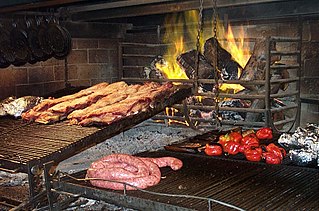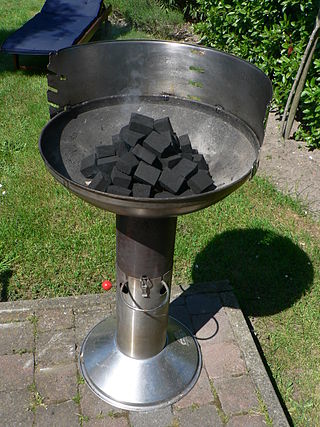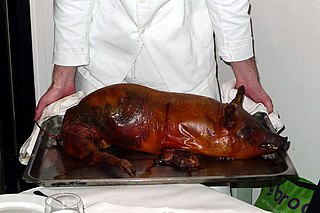
Swiss Chalet is a Canadian chain of casual dining restaurants founded in 1954 in Toronto, Ontario. Swiss Chalet has locations in most Canadian provinces, but about 80% are in Ontario and there are currently none in Quebec or British Columbia. Swiss Chalet is among the holdings of Recipe Unlimited, which also owns the fast food chain Harvey's. Swiss Chalet and Harvey's franchises share many locations.

Fried rice is a dish of cooked rice that has been stir-fried in a wok or a frying pan and is usually mixed with other ingredients such as eggs, vegetables, seafood, or meat. It is often eaten by itself or as an accompaniment to another dish. Fried rice is a popular component of East Asian, Southeast Asian and certain South Asian cuisines, as well as a staple national dish of Indonesia. As a homemade dish, fried rice is typically made with ingredients left over from other dishes, leading to countless variations. Fried rice first developed during the Sui Dynasty in China.

Asado is the technique and the social event of having or attending a barbecue in various South American countries: especially Argentina, Chile, Paraguay, Peru, and Uruguay where it is also a traditional event. An asado usually consists of beef, pork, chicken, chorizo, and morcilla; all of which are cooked using an open fire or a grill, called a parrilla. Usually, red wine and side dishes such as salads accompany the main meats, which are prepared by a designated cook called the asador or parrillero.

Tandoori chicken is a dish made from chicken marinated in yogurt and spices and roasted in a tandoor, a cylindrical clay oven. The dish is now popular worldwide. The modern form of the dish was popularized by the Moti Mahal restaurant in New Delhi, India in the late 1940s.

Roast chicken is chicken prepared as food by roasting whether in a home kitchen, over a fire, or with a rotisserie. Generally, the chicken is roasted with its own fat and juices by circulating the meat during roasting, and therefore, are usually cooked exposed to fire or heat with some type of rotary grill so that the circulation of these fats and juices is as efficient as possible. Roast chicken is a dish that appears in a wide variety of cuisines worldwide.

Rotisserie, also known as spit-roasting, is a style of roasting where meat is skewered on a spit – a long, solid rod used to hold food while it is being cooked over a fire in a fireplace or over a campfire, or roasted in an oven. This method is generally used for cooking large joints of meat or entire animals, such as pigs or turkeys. The rotation cooks the meat evenly in its own juices and allows easy access for continuous basting.

Churrasco is the Portuguese and Spanish name for grilled beef prominent in the cuisines of Brazil, Colombia, Uruguay, and Argentina. The term is used in other Spanish- and Portuguese-speaking countries for a variety of different meat products.

A schnitzel is a thin slice of meat. The meat is usually thinned by pounding with a meat tenderizer. Most commonly, the meat is breaded before frying. Breaded schnitzel is popular in many countries and is made using veal, pork, chicken, mutton, beef, or turkey. Schnitzel originates in Austria as wiener schnitzel and is very similar to dishes such as escalope in France and Spain, panado in Portugal, tonkatsu in Japan, cotoletta in Italy, kotlet schabowy in Poland, řízek in Czech Republic, milanesa in Latin America, chuleta valluna in Colombia, chicken chop in Malaysia, and chicken-fried steak and pork tenderloin of the United States.
Peruvian cuisine reflects local practices and ingredients including influences mainly from the indigenous population, including the Inca, and cuisines brought by immigrants from Europe, Asia, and Africa. Without the familiar ingredients from their home countries, immigrants modified their traditional cuisines by using ingredients available in Peru.

Barbecue varies by the type of meat, sauce, rub, or other flavorings used, the point in barbecuing at which they are added, the role smoke plays, the equipment and fuel used, cooking temperature, and cooking time.

Siu mei is the generic Cantonese name of meats roasted on spits over an open fire or a large wood-burning rotisserie oven. It creates a unique, deep barbecue flavor and the roast is usually coated with a flavorful sauce before roasting. Siu mei is very popular in Hong Kong and Macau, and overseas Chinatowns especially with Cantonese emigrants. In Hong Kong, the average person eats siu mei once every four days, with char siu being the most popular, followed by siu yuk in second, and roast goose being third. Some siu mei such as white cut chicken and soy sauce chicken are not roasted at all but they are still considered siu mei nonetheless. siu mei is also known colloquially as siu laap, as the latter term encompasses siu mei and laap mei, a type of preserved meat. They are usually prepared in the same kitchen during autumn and winter season in what are often known as siu laap establishments or Chinese BBQ shops. Siu laap is also often sold alongside lou mei, such as orange cuttlefish and Pig's ear.

Souvla is a popular dish from Cyprus. It consists of large pieces of meat cooked on a long skewer over a charcoal barbecue.

Chicken parmesan, or chicken parmigiana, is a dish that consists of breaded chicken breast covered in tomato sauce and mozzarella, parmesan, or provolone cheese. A quantity of ham or bacon is sometimes added.

Barbecue chicken consists of chicken parts or entire chickens that are barbecued, grilled or smoked. There are many global and regional preparation techniques and cooking styles. Barbecue chicken is often seasoned or coated in a spice rub, barbecue sauce, or both. Marinades are also used to tenderize the meat and add flavor. Rotisserie chicken has gained prominence and popularity in U.S. grocery markets. Barbecued chicken is one of the world's most popular barbecue dishes.

Arroz chaufa, also known as arroz de chaufa, is a fried rice dish from Peru. It is part of the Chinese Peruvian cuisine, which is called chifa.

Rotisserie chicken is a chicken dish that is cooked on a rotisserie by using direct heat in which the chicken is placed next to the heat source.

A suckling pig is a piglet fed on its mother's milk. In culinary contexts, a suckling pig is slaughtered between the ages of two and six weeks. It is traditionally cooked whole, often roasted, in various cuisines. It is usually prepared for special occasions and gatherings. The most popular preparation can be found in Spain and Portugal under the name lechón (Spanish) or leitão (Portuguese).
















